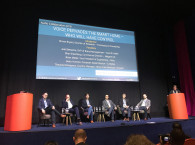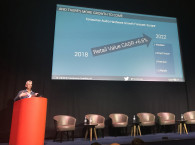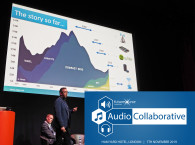This year, Audio Collaborative was an all-day event, held in London, UK, on November 8, 2018, and it was better than ever, with a really great representation of companies and market sectors, alternating between inspiring presentations, discussion panels, and great summaries of Futuresource's market data and forecasts, in front of an audience predominantly consisting of industry professionals. I felt really rewarded for attending the event, not only for the information that was shared, but also for the excellent networking opportunities. The diversity and richness of the topics discussed there make it impossible to fully report in this space - for those interested, Futuresource made audio recordings of all sessions available on YouTube here. I will try to summarize a few key takeaways from the meeting.
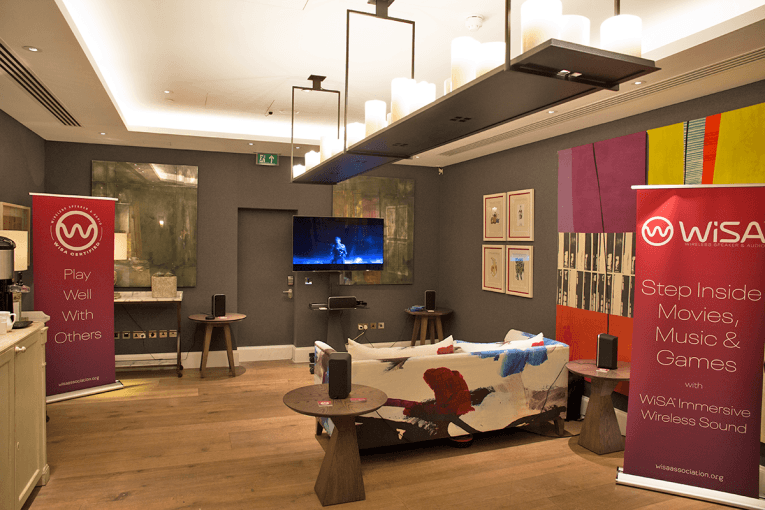
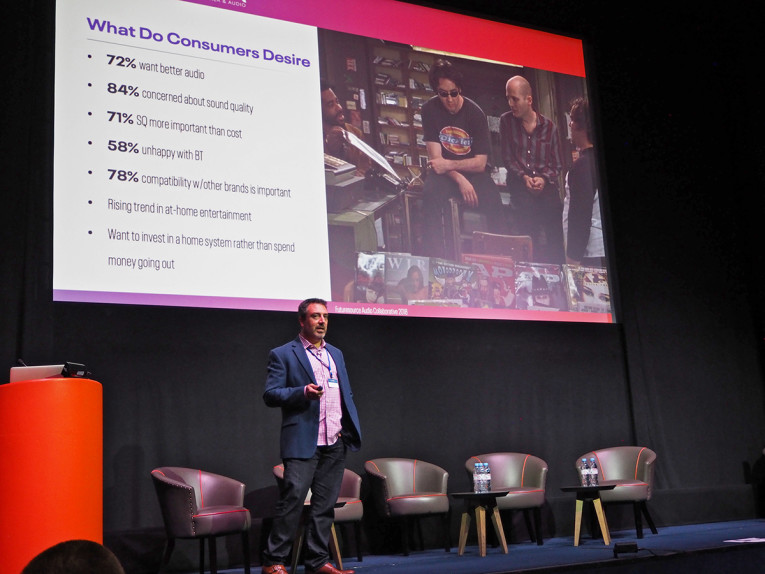
The event started with an opening keynote by Theunis Scheepers, Country Manager, Alexa Voice Services, Amazon, where he shared the company's perspective for its voice assistant strategy, and most importantly, provided a glimpse of expected Alexa's expansion - literally everywhere - in a way that I believe was very useful for the many audio manufacturers and audio industry executives present in the audience. Among key topics shared by Scheepers, we've learned that Amazon believes it will be able to scale the service globally and that language barriers will be overcome, as the company continues to perfect its voice engines for new languages and accents. Following English-speaking countries, Germany, Japan, and India, Amazon is now expanding the service to France, Spain, Italy, Mexico and, very soon, also Brazil. Scheepers also explained that Amazon is determined to foster this expansion with the help of developers and the whole audio industry and that Amazon believes its main focus should be on providing the level of "intelligence" and localization that makes a personal digital assistant useful to different users all over the world. As an example, he explained how hard they had to work to adapt Alexa to work in Japan, first and foremost to make it a native in the country's culture and make it relevant to users.

In terms of Alexa Skills, the key component for the service to be truly engaging and useful - and where Amazon truly opened its content development ecosystem - the growth is a staggering 450% year-on-year, already surpassing more than 50,000 skills today. New skills being submitted are practically doubling every month. Of course, well aware of the specific audience, Scheepers also promoted all the tools and development kits needed to foster that growth and briefly explained how Amazon offers the Alexa Voice Services (AVS) SDK for all types of devices and OEM needs, now with a specific SDK also for TVs and smart screens, a new Alexa Auto SDK for cars, and also solutions for system integrators - a key component not only in the residential market but certainly in the office.
 One of the key takeaways of this presentation for me was the way how Scheepers was fully aware that the whole concept is very much in its infancy and that use cases - now dominated by simple things like interacting with music services or asking Alexa to say a joke or the weather forecast - will be soon complemented with many new capabilities, like the ability to recognize the user's voice and being able to interact with multiple users in the same space. This, while understanding the fact that voice agents are - for now - restricted to voice commands, even if everyone is dreaming about natural language interactions. That's in fact the main reason why Amazon is carefully looking at the user's experience and the way people "learn" to use the platform, in the same way the platform evolves over time as more users interact.
One of the key takeaways of this presentation for me was the way how Scheepers was fully aware that the whole concept is very much in its infancy and that use cases - now dominated by simple things like interacting with music services or asking Alexa to say a joke or the weather forecast - will be soon complemented with many new capabilities, like the ability to recognize the user's voice and being able to interact with multiple users in the same space. This, while understanding the fact that voice agents are - for now - restricted to voice commands, even if everyone is dreaming about natural language interactions. That's in fact the main reason why Amazon is carefully looking at the user's experience and the way people "learn" to use the platform, in the same way the platform evolves over time as more users interact.Importantly, smart home already represents 52% of the usage and this will expand quickly, bringing new needs and challenges, which Amazon believes only the industry together can solve, and the reason why the company is appealing to developers and even brands to develop apps for the Alexa platform. Just in 2018, Amazon attracted 1,500 brands to use Alexa in the smart home space, and there are currently more than 4,000 products available. Amazon is making the whole Alexa integration seamless across the home and provides a solution for manufacturers to connect directly to their cloud. This includes incorporating all sorts of devices with the voice service, including products such as appliances and light fixtures that don't even need to have microphones; simply connecting to the other devices that do. It even makes available a multi-room solution that becomes attractive for audio manufacturers who don't need to develop their own approach. Amazon is also making it possible for proprietary solutions to be connected to the Alexa ecosystem, including via Bluetooth, which is the case with headphones now also connecting to Alexa.
In summary, this presentation from an executive from a key market for Amazon in Europe, makes it perfectly clear of why Alexa is expanding so rapidly, and how Amazon, being a company that just a few years ago was not even considered a technology provider, is now leading the way with voice.

The Amazon keynote was followed by the panel "Voice Pervades the Smart Home - Who Will Have Control?", where Scheepers was joined by Joel Sietsema, SVP of Brand Management - Sound United; Shan Eisenberg, Commercial Director - Netgem UK; Brian Moller, Vice President of Engineering - Roku; and Gerry Holman, European Sales Director - Linkplay. In the discussion, the companies illustrated how they all see far-field voice interaction as a key technology in their strategies, even if in specific areas, such as content services, there are specific concerns with security, providing voice interaction restricted to the device without connection to the cloud, and above all, the challenges of content-specific voice interactions, such as with TVs, where voice is a useful but not the only interface.
Immediately after this panel discussion, Futuresource's principal analyst, Jack Wetherill summed up the discussion by presenting Key Trends and Drivers in the Consumer Audio Hardware Market, which I think left the entire room in celebratory mood.

Among the key messages, Wetherill confirmed that consumer audio is back to growth, with global worldwide trade already representing $32 billion and growing 15% YoY - of course, in great extension thanks to smart audio devices and the adoption of streaming services. Expanding on that depiction, he went on to explain that headphones are the fastest growing category (in units and value), followed by wireless speakers, and soundbars. Using European-focused data, Wetherill illustrated the wireless headphone uptake (which follows a similar trend globally) and explained how streaming music subscribers are largely overtaking downloads and physical media, while also now motivating more people to listen to music than ever, with paid streaming services growing 21% just in 2018. One of the last countries in the world where CD (and vinyl) is still dominant is Japan, with France and Germany being also among the European countries where streaming only now has become the dominant music consumption method (but still almost 50/50 with downloads and CDs), while in the north of Europe streaming already represents 90% of the total music industry consumer spend.
More impressive are the specific statistics for wireless speakers in Europe with a 17% growth YoY in 2018 - an impressive 30 million units forecasted to ship in 2018 - and the enormous boost caused by voice and smart speakers. Considering that until now only the UK and Germany had Alexa available in Europe, smart speakers are doubling in numbers YoY, even if Bluetooth speakers still represent the vast majority of sold units and growing 8% in 2018, while Wi-Fi speakers without voice abilities are being surpassed by smart/voice-enabled devices. Soundbars are also growing by 7% in 2018 and 12% in value, and one of the key takeaways should be the fact that units costing 500 Euros/USD and more (way up to $3,500 in some cases) are selling well, as manufacturers add more features like Dolby Atmos, streaming support, and even voice interfaces. In Europe alone, Futuresource estimates that there are 170 million flat-screen TVs that are still not attached to any augmented sound system, so this represents a massive opportunity for the product segment - and even for next-generation wireless home-theater systems, such as those WiSA is promoting.

After detailing what will happen for each product category in audio, including traditional hi-fi, separate components, and even custom-install, Jack Wetherill closed this audio market overview with a forecast of consumer audio hardware growth in Europe of +6.6% compound annual growth rate (CAGR) between now and until 2022, driven by wireless, smart/voice, premium products and devices that fit people's lifestyle. Estimates for other regions of the world, like the US and Asia, where uptake of the fastest growing categories is faster, is even more optimistic.
A very interesting but complementary discussion about voice applications in the office and business took place after the coffee break, where Chris Mcintyre-Brown from Futuresource Consulting discussed with Bryan Sutton, Director, Technical Sales at Microsoft; Andy Barnes, Executive IT Architect, Watson IOT for IBM; and Dr. Paul Neil, Vice President Product and Marketing at XMOS, about the specific challenges for such uses. Interestingly, all confirmed they believe that the use of voice in the office, apart from the obvious use in conference and collaboration spaces, will be propelled by consumer's adoption and the fact that inevitably users will expect the same voice interface to be available in professional spaces - much in the same way as touch-interfaces have "invaded" corporate applications and were propelled by personal, bring-your-own devices. Of course, as all the panelist agreed, concerns about security are the largest challenge to overcome.

The day continued with fascinating panels discussing live and touring trends, how kids are interacting with technology and entertainment (and specifically smart-speakers and voice), rising opportunities for the Music and Hardware industry in the Games sector; how the pro audio industry can leverage opportunities in the consumer space; new trends and opportunities in the music market with the rise of streaming; and finally a presentation on the use of Artificial Intelligence to create new apps and services.
Hope this will trigger your appetite to attend the next Audio Collaborative event in 2019.
Read more summaries of Audio Collaborative 2018:
Voice Pervades the Smart Home
Live Sound, Pro Audio, Artists, and the Audio Industry
Music Market Outlook - Changes and Opportunities




